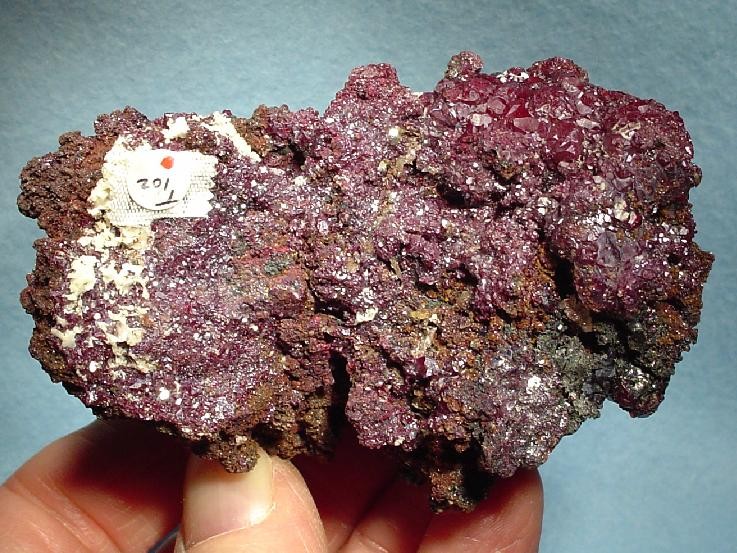Cuprite
Cuprite (deprecated Rotkupfererz, chemically copper (I ) oxide ) is a rarely occurring mineral from the mineral class of " oxides and hydroxides ". It crystallizes in the cubic crystal system with the chemical composition of Cu2O and usually develops various combinations of cubic crystal forms such as octahedron, rhombic dodecahedron and rarely die, but also acicular or granular to massive mineral aggregates of orange-red to almost black color.
Special Features
Cuprite has a Mohs hardness of 3.5 to 4 thus belongs to the soft minerals. It is soluble in acids and ammonia.
Etymology and history
Was first described scientifically in 1845 by the cuprite Wilhelm Ritter von Haidinger, who named the mineral because of its copper content with reference to the Latin term for copper cuprum. Romans called the ore aes cyprium ( ore from Cyprus).
Classification
In the now outdated nomenclature of minerals according to Strunz ( 8th edition ) of cuprite still belongs to the commonly held department of " oxides with ( the approximate molar ratio ) Metal: Oxygen = 2: 1 and 1: 1". Since the revision of the Strunz'schen Mineral classification in the 9th edition, however, this division is precisely subdivided according to the exact molar ratio and the size of the cations involved and the mineral is found accordingly in the subdivision of " oxides with the molar ratio of metal: oxygen = 2: 1 (and 1.8: 1 ".
The more commonly used in English-speaking classification of minerals according to Dana assigns the cuprite in the department of "simple oxides with a cation charge of 1 and of the general formula A2O ".
Modifications and varieties
- Chalkotrichit or copper flower is of a procedural variant with needle - shaped crystals up hair.
- As Kupferziegelerz or short Ziegelerz are designated Limonite on the one hand, the massive and earthy varieties of Cuprits and on the other a red-brown mixture of cuprite and other copper minerals.
Education and Locations
Cuprite is a typical secondary mineral that is formed by oxidation of various copper sulfides and native copper, and especially in the reduction zone of copper, sulphide ore body occurs. Accompanying minerals are mainly native copper, azurite and malachite, but also Antlerite, Atacamit, Brochantite, calcite, chrysocolla and Tenorite. Often he is also overgrown find with malachite in the form of Perimorphosen.
Worldwide, Cuprite be proven so far to over 2,000 localities (as of 2009). A conspicuous number of localities recorded while the countries of Argentina, Australia, Bolivia, Chile, China, Germany, France, Italy, Canada, Mexico, Namibia, Norway, Austria, Peru, Russia, Spain, Sweden, the United Kingdom ( UK), as well as the United States (USA) ..
Good to perfectly developed crystals occurred mainly in the African deposits of Tsumeb ( Namibia) and Shaba (now Katanga ) to light. Up to 15 cm tall overgrown with malachite crystals were found in Onganja (Namibia). But also in Cornwall was found a group of crystals whose size is 3.1 cm.
Crystal structure
Cuprite crystallized cubic space group with the lattice parameters a = 4.2685 Å and two formula units per unit cell.
Two intermeshing asked scaffolds [ OCu4 ] tetrahedra, having no chemical bond to one another, which form the basic structure of Cuprits, also referred to as "double - Anticristobalitstruktur ".
Use
As a raw material
Cuprite is indeed spread far and as a mineral has been mined in ancient times because of the significant copper content of 88.8 %, but the mineral is only occasionally locally as accumulated before that the mining economically worthwhile than copper ore. The mineral can release by simply melts easily significant amounts of copper, thereby a lot of copper recovered.
As a gemstone
For commercial use as a gemstone of cuprite is too soft due to its low hardness and also too sensitive even to weak acids such as welding. He would therefore too easily damaged than fingers or bracelets and generally attacked while wearing too quickly. Seine at good quality bright red color and its strong luster still make it for collectors and hobby grinder to an interesting and sought-after stone that is often sold or traded in faceted form.










